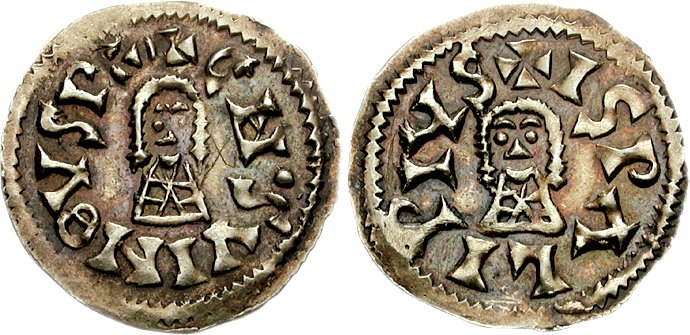Chindaswinth tremissis 642 76001708
Autor/Urheber:
CNG
Attribution:
Das Bild ist mit 'Attribution Required' markiert, aber es wurden keine Informationen über die Attribution bereitgestellt. Vermutlich wurde bei Verwendung des MediaWiki-Templates für die CC-BY Lizenzen der Parameter für die Attribution weggelassen. Autoren und Urheber finden für die korrekte Verwendung der Templates hier ein Beispiel.
Shortlink:
Quelle:
Größe:
690 x 335 Pixel (87281 Bytes)
Beschreibung:
Visigoths in Spain. Chindaswinth. 642-653.
- AV Tremissis (1.56 g, 6h). Hispalis (Seville) mint.
- +CN•SVINLVS PX, facing bust
- +ISPLLIS PIVS, facing bust.
- CNV 411.6; Miles, Visigoths 324b; Chaves 270 var. (obv. legend); MEC 1, 255 var. (same).
- Good VF, toned, small “X” graffito on obverse. Rare.
- The Visigoths were one of many Germanic tribes that invaded the Roman Empire in the fourth century AD. Their early period is most notable for their defeat of the emperor Valens at Adrianople in AD 378 and their sacking of Rome under Alaric in AD 410. Alaric’s successor, Athaulf, led the Visigoths into Gaul and Spain, where they subsequently fought against the Vandals and Suevi for the emperor Honorius. Honorius rewarded them, in AD 417, with his permission to settle as foederati in western Aquitaine. Over the following half-century, the Visigoths rendered relatively faithful service to the empire, until their king Euric conquered much of Gaul and established an independent kingdom. This kingdom was quickly squashed in AD 507 by the Franks under Clovis, and the center of Visigothic power moved to Spain, where it flourished and took hold. The majority of the later kings were relatively weak and ineffectual. A few exceptions were the following: Leovigild, an outstanding military and political leader whose long reign (AD 568-586) ushered in the royal line that continued until the end; Reccared, who officially abandoned Arianism for Catholicism; and Sisebut and Swinthila, whose efforts led to the final conquest of Byzantine possessions in Spain. By AD 711, the decentralizing of power in Visigothic Spain had left the kingdom weak in the face of the invading Arabs, who defeated Roderick, the last Visigothic king. Another Visigothic leader, Achila II, continued to rule in Septimania, but he was also killed by the Arabs in AD 714.
Kommentar zur Lizenz:
Du darfst es unter einer der obigen Lizenzen deiner Wahl verwenden.
Lizenz:
Relevante Bilder

(c) Classical Numismatic Group, Inc. http://www.cngcoins.com, CC BY-SA 3.0

(c) Classical Numismatic Group, Inc. http://www.cngcoins.com, CC BY-SA 2.5
Relevante Artikel
TremissisDer Tremissis ist eine spätantike Goldmünze des Römischen Reiches und seiner nachfolgenden Reiche. Der Tremissis war die Drittelmünze der Standardgoldmünze Solidus und bestand zunächst aus 1,51 Gramm reinem Gold. Diese Münze war insbesondere im 5. und 6. Jahrhundert in ganz Europa und im Mittelmeerraum verbreitet und dürfte zu der Zeit die häufigste Münze gewesen sein. .. weiterlesen
